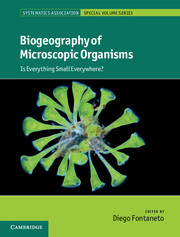Book contents
- Frontmatter
- Contents
- List of contributors
- Preface
- Part I Theoretical framework
- Part II Prokaryotes
- Part III Unicellular eukaryotes
- Part IV Pluricellular eukaryotes
- 9 Coalescent analyses reveal contrasting patterns of intercontinental gene flow in arctic-alpine and boreal-temperate fungi
- 10 Biogeography and phylogeography of lichen fungi and their photobionts
- 11 Biogeography of mosses and allies: does size matter?
- 12 Dispersal limitation or habitat quality – what shapes the distribution ranges of ferns?
- 13 Ubiquity of microscopic animals? Evidence from the morphological approach in species identification
- 14 Molecular approach to micrometazoans. Are they here, there and everywhere?
- Part V Processes
- Index
- Systematics Association Publications
- Systematics Association Special Volumes
- Plate section
- References
9 - Coalescent analyses reveal contrasting patterns of intercontinental gene flow in arctic-alpine and boreal-temperate fungi
from Part IV - Pluricellular eukaryotes
Published online by Cambridge University Press: 05 August 2012
- Frontmatter
- Contents
- List of contributors
- Preface
- Part I Theoretical framework
- Part II Prokaryotes
- Part III Unicellular eukaryotes
- Part IV Pluricellular eukaryotes
- 9 Coalescent analyses reveal contrasting patterns of intercontinental gene flow in arctic-alpine and boreal-temperate fungi
- 10 Biogeography and phylogeography of lichen fungi and their photobionts
- 11 Biogeography of mosses and allies: does size matter?
- 12 Dispersal limitation or habitat quality – what shapes the distribution ranges of ferns?
- 13 Ubiquity of microscopic animals? Evidence from the morphological approach in species identification
- 14 Molecular approach to micrometazoans. Are they here, there and everywhere?
- Part V Processes
- Index
- Systematics Association Publications
- Systematics Association Special Volumes
- Plate section
- References
Summary
Introduction
Many microbial prokaryote and eukaryote morphospecies have been observed to have essentially global distributions (Finlay, 2002). Based on this observation, it has been suggested that populations are so large and dispersal is so effective in these organisms that any tendencies toward geographic isolation and speciation are swamped by gene flow and, hence, that microbes lack detectable biogeography (Fenchel and Finlay, 2004). Where geographic patterning of genetic structure is seen in microbes, the question arises as to whether it is due to selection by the habitat or historical limitations on dispersal (Martiny et al., 2006). Given the tremendous uncharted diversity of fungi, their critical roles in ecosystems, their potential for extensive dispersal by humans (e.g. with agricultural and forestry products), their importance to public health (e.g. mycoses), their valued roles in diverse human societies (e.g. in diverse foods), and the threats posed by rapidly changing climates, it is imperative to determine to what degree fungi have biogeographies.
Fungi share some features with prokaryotic microbes: many species are unicellular and nearly all fungi disperse via single-celled mitotic and/or meiotic spores. They also share many features with other eukaryotes, including discrete evolutionary lineages that are not interconnected by lateral gene transfer. A number of recent molecular phylogenetic studies summarised in Taylor et al. (2006) have demonstrated intercontinental genetic breaks in cosmopolitan fungal morphospecies.
- Type
- Chapter
- Information
- Biogeography of Microscopic OrganismsIs Everything Small Everywhere?, pp. 177 - 190Publisher: Cambridge University PressPrint publication year: 2011
References
- 7
- Cited by



